|
A glimpse into the past...
making
his loss some 3 or $4000, it traveled on destroying fences etc.
Destroyed F. Campbell's house & hurt Mr. C. his wife and 2 children
& his barn it then raised passed over Keota and traveled on about
10 mi. east here where it struck the ground again and the destruction
was terrible killing some 10 persons injuring a great number, the loss
cannot be estimated.
The Newtons,
having a well developed community spirit, took an active interest in
schools, mail services, civic affairs, and farmers clubs. Soon after
their arrival in the west, Hosea was elected sub-director of the school
board, and in May, 1859, Hosea and Hanno helped to build a schoolhouse
on the Newton land.
Church played an
important part in the life of the family. While at Fair Haven in 1848
they had all been baptized in the Episcopal church, and Sundays were
spent at church—"all day and evening." During their first years in the
west there were no churches, but Sunday School was held in the
schoolhouse as early as July, 1859, and soon after this they arranged
to have itinerant preachers conduct church in the schoolhouse. The year
after the railroad was built and the new station at Keota established,
interested folk got together, chose two lots for a Methodist church,
formed a board of trustees, and on May 12, 1872, "Mr. Smock preached
the first sermon in Keota," and the Newtons were present in full force
to hear him. While there seems to have been some interest in
spiritualism about 1860 in the neighborhood, only one mention was made
in Hanno's diary of their attending a meeting.
For years
Talleyrand was their mail center. About once a week someone would go
after the mail for the neighborhood, that task usually being assumed by
Hanno. Later on they had post office meetings, some at the Newton home,
but wherever they were held, the Newtons always attended. However, up
to 1874 no change had been made in their mail arrangements.
In civic and
political matters the Newtons always showed keen interest. In 1862
Hosea was justice of the peace, using the authority of his office to
perform marriage ceremonies and to make out deeds. In 1862 Hanno was
constable, and in 1872 he was elected town clerk. Politically they were
Republicans. Once, however, Hosea strayed from the fold and joined a
new party known as the Anti-Monopolists. He threw his hat in the ring
and was elected state senator, serving in the 1874 and 1876 sessions of
the General Assembly at Des Moines. Hanno's description of the election
follows:
Oct.
14, 1873, Election Day, the election was held at Keota for this Twp.
Everything passed off very well. 190 votes cast. A pleasant and nice
day. Oct. 15th. got through counting out last night about 3 P.M. I took
the train at noon for Sigourney to take the returns up.
Anti-Monopolists quite jubilant over their success. Father's majority
for senator, 415.
Further mention
is made in the diary of the times that Hosea went to Des Moines during
the 1874 and 1876 sessions, but nothing is recorded of what part he
took in the proceedings. The Senate Journal indicates that his
defection from the Republican party lasted only one term, that of
1874; in the 1876 Journal, Hosea voted with the Republicans.
He was one of the few Republicans who had defected
to the Anti-Monopolists; when it seemed that the Democrats
were taking over this third party movement, most of
the Republicans returned to their former allegiance.
Hanno's
experiences during the Civil War had probably strengthened his
Republicanism. He had joined the Iowa State Militia when the war broke
out, but the only bit of excitement he recorded was during the first
few days of August, 1863, when he played a minor role in the shortlived
uprising at South English which came to be known in Iowa history as the
"Tally War." The Rev. Cyphert Tally of Keokuk County, a Baptist
minister with a southern background, led a group of
Dernocrats—'Copperheads" in the minds of all Republicans—into South
English during a Republican rally there. Tally was shot down and died
shortly thereafter. Hanno recounts his part in the ensuing hysteria:
Aug.
1, 1863. 7 P.M. started for Scotland...heard the report that there had
been a fight at South English one man killed. Came on home mustered a
crowd and I went up there with them.
Aug.
2. arrived at S.E. at daylight, a good deal of excitement. Sent a comm.
to confer with the Copperheads.
Aug.
3. I stood on guard last night. Great excitement on account of the
committee not returning sent out spies recruits comeing (sic) in from
all quarters.
Aug.
4. Stood on guard last night. Col. Chipman of Washington took command
today. P.M. built barricades and rifle pits at all of principle
entrances. About sun down the Home Guards of Washington came with 40
extra stand of Arms.
Wed.
Aug. 5. Had a very heavy rain last night. The Sheriff arrested 10 men
today and started for Iowa City with them. About 100 men staid the bal.
went home. I came home in the afternoon. The Governor (Samuel J.
Kirkwood) went through Talleyrand and on to Sigourney. 4 companies of
Militia at Sigourney.
Thus ended the
Tally War and Hanno's military service.
World events
affected the lives of the Newtons in only a remote way, and were
reported merely as items of interest. A few such items mentioned were:
a total eclipse of the sun at 5 P.M. on July 7, 1869; the celebration
of the transmission of Queen Victoria's message over the Atlantic
telegraph (about which they first heard in a letter from a friend in
the East); and the Chicago fire, which news was also received by
letter. The question of equal rights for women was debated at their
Lyceum as early as December 21, 1858.
The progressive
building up of the territory can easily be traced by the changing of
trading centers. When the Newtons first started their building program
in 1858, finishing lumber and other materials were hauled from Iowa
City, 40 miles away; by 1867, when the addition was built, Hanno "went
to Washington for lumber," 22 miles away; and in 1872, "Father went
over to Keota and bought a load of lumber," one mile away, and he "got
home at 9 AM." —a far cry from the three-day trips they had made
fourteen years before.
11
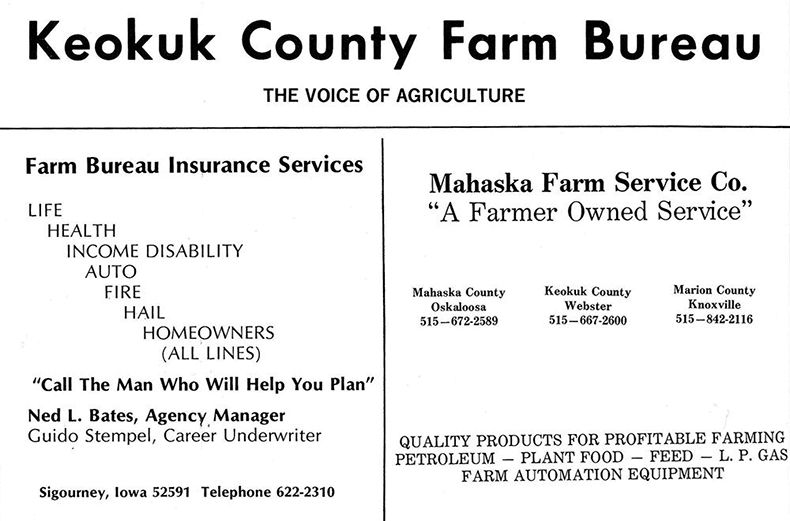
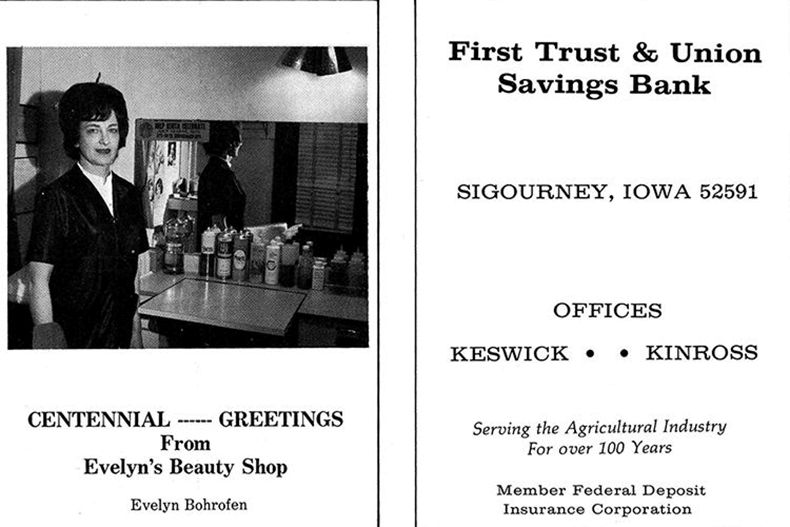
12
|
A glimpse
into the past...
Pioneers are distinguished by one thing in
particular— they can lay claim to many firsts. Hanno recorded some of
them: they bought their first sewing machine from Chicago in 1871;
their first coal stove for the "front" room in 1863; on January 7,
1864, Hanno went to the "coal bank" for their first load of coal; Hosea
Newton and J. Sherman laid the first rail for the railroad in Keokuk
County; Hanno rode to Keota on the first train that went across Clear
Creek on February 26, 1872; the first lumber which was brought into
Keota by train was on March 1, 1872; and the whole Newton family heard
the first sermon preached in Keota on May 12, 1872.
|
 |

The Old Newton Homestead. |

Cattle killed by lightning on the Sander McCrabb farm. Insured by
Pioneer Mutual Insurance Co. |
|
THE
PIONEER MUTUAL INSURANCE
ASSOCIATION
The Pioneer Mutual
Insurance Association was first organized as a township insurance
association. In 1886 the township organization was reorganized and
incorporated to include all of Keokuk County. It was incorporated as
the "Farmers Pioneer Mutual Insurance Association of Keokuk County."
The original officers were James Lyle, President; D. Keiser, Vice
President; H.P. Newton, Secretary; James Chesney, Treasurer. At its
origin it had $22,483 of insurance in force and paid claims of
$1,129.01 in 1894, which are the oldest financial records to be found.
|
 |
|
In 1953 the Corporation Articles were amended and
the name was changed to "Pioneer Mutual Insurance Assoc-iation." In
1973 the officers are Howard Williams, Ollie, Iowa, President; John
Newman, Agency, Iowa, Vice-President; William Werning, Keota, Iowa,
Secretary-Treasurer; Ronald Shafer, Keota, Iowa, Assistant
Secretary-Treasurer.
The Association is now allowed to operate in
Keokuk, Washington, Iowa, Poweshiek, Mahaska, Wapello and Jefferson
Counties. In 1972 the Association had $66,112,351 of insurance in force
and paid claims totaling $137,124.13.
Pictured is one of the most severe lightning
claims handled by the Association. This happened on the Sander McCrabb
farm, which is now the Donald Fagen farm. The year of this catastrophe
is unknown, but judging by the horses and buggies in the background it
happened at about the turn of the century. It would seem by the picture
that the neighbors came in with their spades to help bury the animals.
|
13
A glimpse into the past...
Incorporation of Keota.
STATE OF
IOWA, Keokuk County, ss.
Be it remembered that
heretofore, to-wit: On the 26th day of September, A. D., 1873, there
was filed in the office of the Clerk of the Circuit Court of Iowa, in
and for said county, a petition in the words and figures following:
Keota, Iowa,
August 1st, 1873
To the Honorable Circuit
Court of Keokuk County: We, the undersigned qualified voters, residing
within the district (below bounded) desire to be incorporated under the
name of Keota, and hereby petition for authority to call an election
for the purpose of deciding whether we will or will not incorporate.
(Signed.)
F. M. Smock, J.
F. Wilson , et al.
BOUNDARIES
OF KEOTA
Commencing at
S.E. corner of Sec. 24, T. 76, Range 10
W., running thence north 40 rods, thence west 160 rods, thence south 40
rods, thence west 60 rods, thence south 80 rods, thence east 60 rods,
thence south 40 rods, thence east 160 rods, thence north 120 rods to
place of beginning.
The above
petition was granted by Judge L. C. Blanchard
at the Nov. term of the District Court of Keokuk county, 1873, and F.
M. Israel, J. C. Huskins, F. M. Smock, W. P. Davis and J. S. Kulp were
appointed commissioners to hold said election.
Election
notices dated Nov. 27, 1873, were posted
according to law, calling the election on Dec. 18th, 1873.
The election
was held on Dec. 18th, 1873, at which 68
votes were cast for incorporation and 9 votes against incorporation.
Notice of
incorporation was published in the Keota
Plaindealer, Jan. 1st and 8th, 1874.
Election
Notice
There will
be a special election held at the drug store of J. S. Kulp in the Town
of Keota, Keokuk County, Iowa, on the 18th day of December, 1873, at
which said election the polls will be opened at 9 o'clock A.M. and
continue open until 6 o'clock P.M. for the purpose of deciding whether
said Town of Keota shall be incorporated. All persons wishing to vote
in favor of said incorporation, will write or print "for incorporation"
and those wishing to vote against said incorporation, will write or
print, "against incorporation" on their tickets.
Commissioners:
F. M. Smock, J. C. Huskins, F. M. Israel, J. S. Kulp, W. P. Davis.
STATE OF IOWA,
KEOKUK COUNTY
OFFICE OF THE
CLERK of the DISTRICT
and
CIRCUIT COURTS
M. Wightman
Clerk Sigourney, Iowa, Jany. 20th, 1874
To the Town Council of Keota
Gentleman
We inclose
herewith a Transcript of all the papers in
the matter of the Incorporation of Keota. You can transfer to your
Records such portions as you desire, and afterwards return it to the
office of the Recorder and have it filed for Record, thereby saving the
expense of another transcript.
We have also
prepared a second transcript, and will
forward the same to the Secretary of State. The Clerks fees
are as follows,
Transcripts
(2)
$3.20
Cert.
& Seal
(2) 1.00
Postage
for
2. .30
$4.50
The Recorder
will write you concerning his fees.
Yours
Resptly. M. Wightman
Clk .
By Geo. W. Halferty
Depty.
*************************
July 8, 1876. At least 5,000
people attended the Centennial at Keota. The town was gay with bunting.
The finance committee has paid every cent of the expenses and has a few
dollars left which they will put at interest till the next
Centennial, to form a nest egg for the expenses of the celebration at
Keota in 1976.
*************************
July 29, 1876. The third story
of the Singmaster new brick building will be used as a Masonic Lodge
room. (Note: This
building now in 1973, is known as the Lillig building). Under the
corner stone, properly sealed, were placed a copy
of The Keota Eagle, a silver quarter and one of J. S. Kulp's Catarrh
Remedy circulars.
*************************
May 4, 1878. The Farmer's
Insurance Association is now ready to do business. On April 27 the
following were elected officers; James Lyle, President; J. H. Stouffer,
Vice President; S. Correll, Secretary. Committee: John Black, T. P.
Stoner, Liberty Township; Wm. Chesney, John Randolph, Lafayette
Township.
14
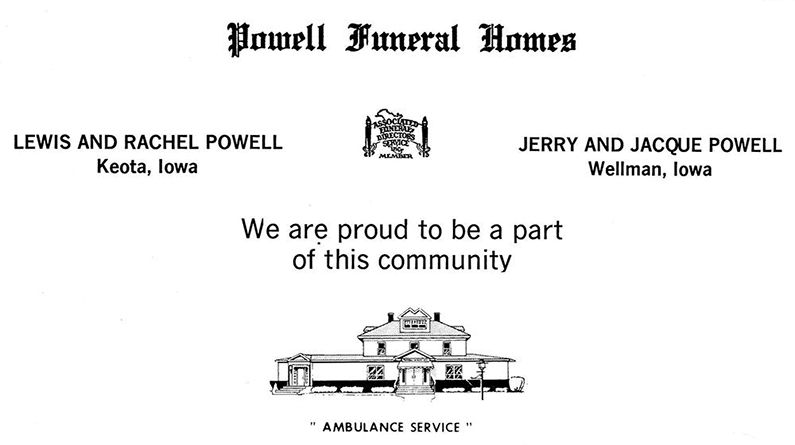
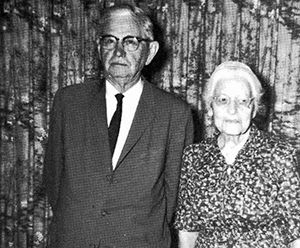 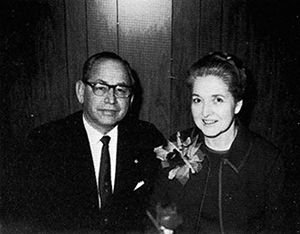
Mr.
& Mrs. Lewis Powell
Sr. Mr.
& Mrs. Lewis Powell Jr. |

Richard and Nancy Adams and Family |

Doug
Powell |
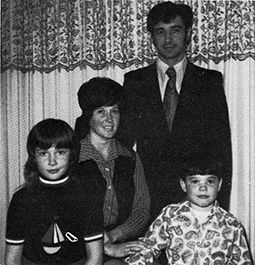
Jerry & Jacquelyn Powell & Family |
15
A
glimpse into the past...
KEOTA CENTENNIAL CELEBRATION
JULY 4, 1876
Address by "Ike" Farley,
pioneer Keota citizen and Keota's first attorney. He was admitted to
the bar May 2, 1873, shortly after he came to Keota.
**********
1776 E
Pluribus
Unum 1876
CENTENNIAL
AT KEOTA
A
Historical Sketch of Town and Township
By
HON. ISAAC FARLEY
Mr.
President-Fellow Citizens:-
In compliance
with the recommendations of the Congress of the United States of
America, seconded by his excellency, Samuel J. Kirkwood, Governor of
the State of Iowa, we have assembled in this beautiful grove, not as
citizens of any particular locality, but as citizens of the United
States of America, as citizens of one common country. We have left our
fields, our workshops, our offices, and places of business to pledge
anew our fealty, to that flag, which has protected and supported us in
all the peaceful avocations of life at home, and insures protection and
respect abroad, and to unite in celebrating this Centennial day which
gave our Nation birth.
Therefore in compliance with
the recommendation before referred to, we will avoid the usual style of
4th of July Orations, and contribute our might towards making up the
history of this great day, by giving to you, to the country and to the
world at large an historical sketch of the town of Keota and of
Lafayette Township. Lafayette Twp. is situated in the eastern part of
Keokuk County, State of Iowa, between parallels 41 and 42 North
Latitude; and meridians 92 and 93 Lon. West of Greenwich; its Territory
comprises 36 square miles of gently undulating prairie, interspersed
with a few groves of native timber; Crooked and Clear creeks furnish
stock water and drainage for most part of the township.
The soil is a dark friable
loam of an average depth of two feet, underlain with a rich deep
subsoil, which renders the productive qualities of the soil of almost
infinite durability; and is adapted to the production of all crops
usual to this latitude.
The first white settler was
Mr. Roe Clemmons, who settled in 1842 in the N. W. part of the township
near what is now known as Holsworth's grove. This township though not
excelled in Iowa for beauty and fertility of soil, on account of
scarcity of timber, was not settled as early as other portions of the
county where timber was more abundant. In fact our most beautiful
prairies were shunned by early settlers. Inhabitants of today whilst
contemplating our broad prairies dotted with neat, commodious
dwellings, barns, orchards and artificial groves look back with
surprise at the choice of our first settlers. The uninviting features
of our Western Prairies reminds me of a poem descriptive of them, which
I used to read in my boyhood days. The poem was the production of
Josiah D. Channing. I give it as I recollect it:
O,
lonesome, windy, grassy place,
Where
buffalo and snakes prevail,
The
first with dreadful looking face,
the
last with dreadful sounding
tail.
I'd
rather live on Camel Hump
And
be a yankee-doodle beggar
Than
where I never see a stump,
And
shake to death with fever
'nagr.
Fortunately for the settlers
of this township owing to its high and dry surface, they were seldom
afflicted with malarial diseases, and ague and fever have been almost
unknown among our citizens. In 1843 came J. J. Kreamer and J. P.
Kreamer and settled on Clear Creek, in the south part of the township.
This was prior to the time when the land was put into market.
Consequently settlers at that time were known as "squatters."
In March, 1855, this township
was organized according to law, and the first election of officers was
held in pursuance thereof. The township then contained about 50 souls,
of all ages and sex. Female suffrage not having been adopted the number
of voters did not exceed one dozen and as a result of the election each
voter in the township found himself elected to an office, some filling
two and three offices, thus verifying the assertion of the boy who
wrote to his father to come out here, as this was the best place in
America for a mean man to get office.
The land in this township had
previously been entered by speculators, (a greatest obstacle to the
settlement of a new country), they holding their land till such time as
the toil and improvement of the bona-fide settlers shall have enhanced
the value of their land five or ten or twenty dollars per acre. But the
few settlers of this township, being of a literary turn of mind, made
the important discovery that educational facilities were the paramount
object in the settlement of a new country, consequently set themselves
to work, levying enormous taxes upon the lands of speculators for
school purposes. This course soon brought the speculators' lands into
market, and erected neat and commodious schoolhouses upon each four
sections of land in the township.
Six of the first settlers,
to-wit: The Kramers, Newton, Gilbert, Keeley and Carris, now live upon
the land they first entered. At the breaking out of the War of the
Rebellion, this township comprised about 200 souls. Twenty-one of their
sons voluntarily left their prairie homes, and placed themselves in
front in the great struggle to preserve and maintain the right to
celebrate this great day. Of this gallant few, not a white feather was
ever seen sticking even to the shirts of their garments. Of these,
seven sacrificed their lives upon the sacred altar of liberty. Seven
hearthstones in this prairie township made desolate, and draped in
gloom for the loved ones who should return no more. Fourteen of the
number through the blessing of a kind Providence, after having done
their whole duty, returned to the anxious, tender and loving embrace of
home— not demoralized by Army vices, but nobler still for the noble
cause in which they had been engaged.
16


17
A
glimpse into the past...
And now we give
this brief summary of Lafayette township: 1855 finds a scattered
settlement of 50 souls, with but a few acres in cultivation, near 100
miles from any market, deprived almost entirely of the luxuries of
life, yet blessed with health and a fixed determination to carve out of
this prairie wilderness homes for themselves and their posterity.
Behold the transformation! Pass over a period of 20 years, and
Lafayette township has a population of over two thousand souls. Nearly
every rod of her broad acres brought into cultivation by the
husbandman, yielding a rich abundance as the reward of intelligent
labor. On every hand are seen beautiful groves, neat farm houses,
commodious barns, trees and vines bending with their burden of luscious
fruits, well worked highways, and scores of miles of living hedge.
Within its borders are two busy flourishing towns, through which plows
the iron horse bearing its immense train of the commodities and
luxuries of all parts of the globe to their very doors, also furnishing
a market for the immense surplus of wheat, corn, oats, rye, barley,
horses, cattle, hogs, and various other productions ofthis thriving
people. Where 20 years ago a long weary horseback ride was the quickest
method of communicating intelligence with other parts of the country,
now the telegraph wire flashes its message of business, love, hate and
of hope and disappointment with the rapidity of lightning, and when the
British lion roars, or Russian bear growls, or the Sultan fumes, or
Bismarck scowls, the next hour the shrewd farmer has calculated the
chances of a European war, and has raised the price of his corn, wheat,
hogs, etc., accordingly. Where 20 years ago farmers' wives and
daughters made music with the spinning wheel, harmony sweet now swells
from the piano, organ and guitar, brought out by the jeweled fingers of
the fair dames and daughters of this prairie. Where 20 years ago the
lumbering wagon and saddle were the only means of travel among our
early settlers, today the light buggy, the elegant barouche and
magnificent carriage, with their costly trappings, are used by these
people who have so richly earned them.
I must leave the
pleasant contemplation of this scene of real beauty and thrift, and ask
your attention to the more immediate subject of my sketch, the Town of
Keota.
Keota is located
on the eastern border of Lafayette Township, on the divide between
Skunk River on the south and English River on the north, surrounded by
as fertile prairie as the sun ever shone upon, which being occupied by
an intelligent class of farmers, affords to Keota a business support
excelled by none, and equaled by few inland towns in this or any other
state in the Union. The Oskaloosa branch of the C.R.I. & P.R.R.
passes through the town on a line due east and west, thus avoiding the
obtuse and acute angles so often seen in the business part of our R.R.
towns.
Keota was
originally laid out by Messrs. Achard and Yerger of Sigourney, some
time in January, 1872. The present limits of Keota are 3/4 of a mile
east and west, and 1/2 mile north and south. The first money paid for
farm produce was by F. H. Farley, for corn, in January, 1872. The first
building erected was a drug store by J. S. Kulp, commenced Feb. 14th,
1872, and is still occupied by Mr. Kulp for the same business. About
the same time M. Maurer erected the first dwelling, soon followed by
first general merchandise store of Henkle, Littler & Co., said firm
still continuing business in the same stand, though much enlarged.
The town was
incorporated December 1873, J. S. Kulp being chosen first mayor. Keota
Independent School District was organized August 1873, without
schoolhouse, school fund or other school facilities. December following
they had completed a magnificent school building, with two schools,
capable of accommodating 125 scholars. At present, we have four schools
capable of accommodating 250 scholars which is not more than the
present number of scholars resident in the town. Our schools have been
under the superintendance of Professor C. G. Glenn, whose
administration has been marked with such success that our school,
though young, takes rank with the first in the country.
The first church
organization was the Presbyterian, under the charge of Rev. D. V.
Smock, who erected the first place of worship, called Smock's Hall.
This society is in a flourishing condition, having since built a
handsome church, at a cost of $4000, and paid for it. The Baptists,
Methodists and United Presbyterians have each built beautiful temples
of worship, at an aggregate cost of $12,000. These societies are
increasing rapidly in membership, and are out of debt. Rev. D. V. Smock
has been the only minister in charge of the Presbyterian society.
Rev. Tracy is the
present minister in charge of the Baptist society, Rev. Davis of the
Methodist society, and Rev. Barnes of the U. P. society. These
different societies successfully control a membership of over 300
Sabbath school pupils.
The Keota post
office was established in March 1872, Hon. J. F. Wilson being appointed
P. M. and has held and acceptably discharged the duties of said office,
to the present time, and if a vote of the people of Keota could decide
the matter, Uncle Johnny would be delivering mail to the centennials in
1976. Uncle Johnny's salary for the first four months was one dollar
per month. His salary for the year ending July 1st, 1876, is over $900.
Perhaps these postal items will as well illustrate the unprecedented
growth of the town and county, as any other facts. This office was made
a money order office July 1st, 1874. On the 7th day of the same month
the first money order was issued through this office by Isaac Toman,
Richland, Iowa, to C. W. Stephens, Chicago. Within the short space of
two years the number of orders has exceeded 2500, and during the month
last past, over $2250 has been thus transmitted.
Of fraternal
societies we have two. Enterprise Lodge I.O.O.F. of Talleyrand was, on
the 28th day of September, 1872, removed to Keota. This lodge is in a
flourishing condition, having a membership of 68. Present officers J.
H. Stauffer, N. G.; J. S. Kulp, V. G.; D. McFarlane, Treas.; H. P.
Newton, Sec.
Adelphi Lodge No.
353, A. F. & A. M., was organized under dispensation, July 3rd,
1875. Number of charter members, 18. Charter granted by Grand Lodge of
Iowa, June 6th, 1876. Present membership, 33. Present officers: Isaac
Farley, W. M.; H. P. Newton, S. W.; D. McFarlane, J. W.; E. Moses,
Treas.; E. M. Ritchey, Sec. This young lodge is in a healthy working
condition, composed of true and noble "Fraters."
18


19
A
glimpse into the past...
The first
resident physician of Keota was Dr. McFarlane, soon followed by Drs. R.
S. Brice, T. B. McWilliams, F. B. Home, and J. C. Hunter, all of whom
are gentlemen of ability, and an honor to the profession. With the
exception of Dr. McWilliams, who has sought more lucrative fields of
labor, these gentlemen retain their practice here. This shows well for
the ability of our medical men, and the health of our city. Whereas
five were needed in our first year, now only four are required to keep
the people well.
Your humble
servant has the honor of being the first attorney in Keota,
establishing a law office in said town July 1st, 1873, and though the
people of this city seldom quarrel, and always pay their debts, he has
been able by close application to business and strict integrity, to
gain a comfortable living and pay office rent. J. B. Irwin also
established a law office in this city in the fall of 1874, and has
done, and is yet doing, a lucrative business, by exhibiting those rare
virtues so common to attorneys, and beautifully illustrated in the
history of G. W. and his little hatchet 100 years ago.
Prof. J. R.
Dunham, first professor of music, located in this city in 1873. After a
short experience in mercantile business, turned his whole attention to
his profession, with great success as a teacher in instrumental and
vocal music.
The first
newspaper printed in Keota was the "Keota Plaindealer," in 1873, edited
by O. H. Woods, which, after a sanguinary struggle for life for about
six months finally passed into the hands of S. C. Bruce under the
cognomen of "Keota Courier," and while attempting to curry the people
of this place, curried itself to death, and sought, with its editor,
other parts where both might be better appreciated. About Jan. 1st,
1876, G. C. Miller started the "Keota Eagle," a neat, lively, readable
seven column paper. This Eagle soared steadily for about five months,
when it was captured by Messrs. Wells & Reed, two gentlemen of
means and ability. Its present editor, Mr. G. L. Reed, is the right man
in the right place, and their foreman, Mr. S. P. Bailey, is master of
the position, as his work will show, from every sentence of the Eagle
to the ornamental bill and letter heads, and most exquisite card of the
"Beau Monde." The subscription list of The Eagle is now over 500, and
we venture the prophecy that, ere the next 4th of July, the Eagle will
spread its wings over the happy homes of more than 1000 patrons. In
parting with the Eagle we can only say: may its course be onward and
upward, and its shadow never grow less.
In 1875 the
banking house of Littler, Henkle & Co., and the Keota Loan and
Savings Association (F. M. Israel, cashier), were established to meet a
demand much felt by our business men. These institutions have well met
the demands of our citizens, and have done within the past twelve
months, an exchange business of over $900,000. The last named
institution is now erecting, at central Broadway and will soon have
completed, a magnificent iron front, brick building, which will be a
credit to the proprietors and our city.
During the summer
of 1875 Messrs. Smith & Hefflefinger completed the Keota Flouring
Mills. Mr. Hefflefinger retiring, the firm now stands Smith, Stickley
& Smith. These gentlemen are practical millers, and thorough
business men. This mill is one of the most thorough and complete
flouring mills in the state, having all the improvements of modern
science, and a capacity of 100 barrels flour per day, and through the
well merited reputation of this mill, the orders to the company compel
them to run to full capacity, thus turning out 100 barrels superfine
flour each 24 hours, and yet they are only able to partially fill their
orders. The business of this mill will amount in the aggregate of
$300,000 annually.
In addition to
the business above referred to, we have in Keota, four stock dealers,
doing an annual business of over $300,000; two grain buyers and
shippers with a business of $300,000 annually; one general produce and
shipping emporium, doing a business annually of $50,000; one exclusive
clothing house, annual sales $25,000; four general merchandise houses,
annual sales $160,000; four exclusive grocery houses, annual sales
$60,000; one auction store, annual sales $30,000; three drug stores,
annual sales $30,000; two hardware stores, annual $25,000; two
furniture houses, annual sales $20,000; two lumber yards, annual sales
$100,000; two agricultural implement houses, annual sales $45,000, six
milliner establishments, annual sales $10,000; one book store, $2000;
one jewelry store, annual sales $5000; two hotels, annual receipts
$10,000; two boarding houses, annual receipts $4000; three restaurants,
annual receipts $9000; one stove and tin shop, annual receipts $10,000;
five saloons, receipts $18,000; one tailor shop, $2000; two photograph
galleries, annual receipts $4000; one foundry, annual receipts $4000;
one planing and turning mill and organ factory, receipts $5000; three
blacksmiths shops, $15,000; three wagon shops, $15,000; three harness
shops, $20,000; two shoe stores and shops, $15,000; two barber shops,
$2000; two meat markets, annual receipts, $26,000; three livery
stables, annual receipts $21,000; five carpenter shops, $8000; one
cooper shop, receipts $1000; two nurserymen, $9000; one bakery,
receipts unknown. Thus showing a total business transaction annually,
by our commerical and mechanic firms of over two million dollars. Add
to this the proceeds of the different professions, and it will swell
the sum to near two and a quarter millions of dollars. We would remark
right here that instead of the foregoing being an overdrawn picture of
the business transactions of our young city, the statements are rather
under the real amounts, as we have taken most of the estimates from the
sale books of the parties concerned. No person acquainted with our city
will say that I have represented any business that does not exist here.
Yet if asked to guess the number of business firms in the town oldest
citizens would not put them higher than from 40 to 50 at most, yet as
the foregoing will show, 95 such firms exist, and transact business in
our town.
As a further
proof of the great amount of business transactions at this place, I
have but to refer you to the statistics of shippings to and from this
point, for one year, as kindly furnished by our gentlemanly Station
Agent, J. T. Webber. This list comprises only that shipped as freight,
not including express shipments, which class was simply enormous. The
following gives the number of cars of freight to and disbursed at this
point, each car received averaging 22,000 lbs. for the year ending
April 30th, 1876:
20
|